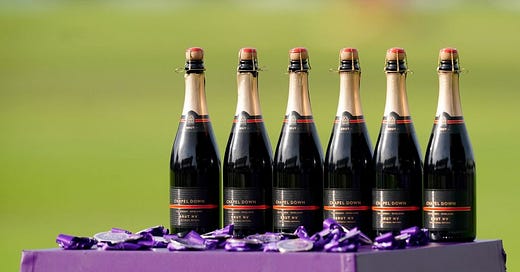Thanks for reading Off to Lunch. If you are not already a paid member, please sign-up below to read today’s newsletter in full, receive our Sunday press review, attend our forthcoming events and contribute to the work of Off to Lunch
“I'm looking forward to it. I think it's good and I think there'll be more that come because it will get harder and harder to make Champagne in the Champagne region. They will keep looking over. I think we have got to have a vision that when you drive down the M20 it’s the same as driving through France and the different wine regions. I want people to be seeing vineyards either side of the road and flourishing.”
That’s Andrew Carter, the chief executive of Chapel Down, the largest winemaker in the UK. We are talking at the company’s winery near Tenterden in Kent, overlooking vineyards that until recently didn’t exist. Carter is discussing the arrival of Tattinger, one of the leading Champagne houses, in the UK. It has established a vineyard nearby and plans to launch its own English sparkling wine to consumers in 2024. As yet, the name and details of the sparkling wine are under wraps, but Tattinger’s impending launch is a validation of how much English sparkling wine has developed, as well as the impact of extreme weather and heat in France, which is complicating work in Champagne.
Josh Donaghay-Spire, Chapel Down’s head winemaker, adds: “We've been growing here since 1977 and people thought the guys back then were crazy and just wasting their money by growing grapes in England. But to have a brand like Tattinger plant basically next door is a huge endorsement of everything we've been doing. To have them as neighbours is brilliant.”
The rise of English sparkling wine has been one of the biggest business success stories in Britain in recent years outside London. A new industry and new brands have emerged from the countryside in Kent, Sussex and Hampshire. Chapel Down, which was only established as a company in 2001, reported a 39 per cent rise in sales of sparkling wine by volume in 2021, selling more than 1.5 million bottles. The company is targeting double-digit growth again in 2022. As well as Chapel Down, brands like Nyetimber, Ridgeview and Gusbourne have emerged. In total, 9.3 million bottles of English wine were sold in 2021, a 32 per cent increase, according to WineGB data. Of that, 5.8 million was sparkling.
However, Carter and Donaghay-Spire believe Chapel Down and English sparkling wine are just getting started. English vineyards still account for only a small portion of the 240 million bottles sold in this country in 2021, a market dominated by prosecco and cava.
Chapel Down is planning to build a new winery to meet demand. Future developments on the agenda for the industry as a whole include the growth of English red wine, specifically Pinot Noir.
“I think that is something that will become more interesting to a lot of parties and us over the next decade,” Carter says on English Pinot Noir.
“It's still quite challenging commercially because you end up having to charge the best part of £30 for your bottle of Pinot Noir and it's got to compete against Pinot Noirs from other parts of the world. But I think as the temperature continues to move there will be other variations that we're not growing that much of at the moment that will become more easily grown. We're not going to start producing Cabernet or Merlot or the like. But we will, I think, produce much better Pinot Noir over the next decade or so. I'd like to think we'd be part of that.”
It feels particularly relevant to discuss the temperature as the sun powers down and we are forced to seek the shade to talk. The UK has been hit with record temperatures over the last week, with 40C being cleared for the first time. Rising temperatures are a key part of the English sparkling wine story. The south-east of England has always had much in its favour when it comes to making wine, including the chalk in the ground that is in the Champagne region and runs under the English Channel to this part of the world. The maritime climate also gives English sparkling wine a freshness that you don’t find elsewhere. However, it is rising temperatures that have unlocked this potential, allowing grapes to be grown that you couldn’t before.
“The Romans were making it,” Carter says of wine in England. “It's really the change in temperature over the last 40 years that has enabled the level of change. A lot of what was originally planted here was Bacchus or the Germanic varieties because that was what you could grow in the UK maritime climate of the 70s and 80s. The change in temperature has meant that we've then been able to start growing the champagne grapes - Chardonnay, Pinot Noir, Pinot Meuniur - far more successfully.”
However, Donaghay-Spire is also keen to emphasise how Britain has gotten better at making wine.





